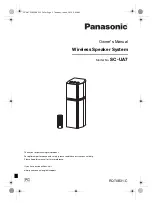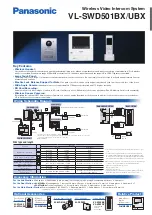
1 Safety Precautions
1.1. General Guidelines
1. When servicing, observe the original lead dress. If a short circuit is found, replace all parts which have been overheated or
damaged by the short circuit.
2. After servicing, ensure that all the protective devices such as insulation barriers and insulation papers shields are properly
installed.
3. After servicing, check for leakage current checks to prevent from being exposed to shock hazards.
(This “Safety Precaution” is applied only in U.S.A.)
1. Before servicing, unplug the power cord to prevent an electric shock.
2. When replacing parts, use only manufacturer’s recommended components for safety.
3. Check the condition of the power cord. Replace if wear or damage is evident.
4. After servicing, be sure to restore the lead dress, insulation barriers, insulation papers, shields, etc.
5. Before returning the serviced equipment to the customer, be sure to make the following insulation resistance test to prevent the
customer from being exposed to a shock hazard.
1.1.1. Leakage Current Cold Check
1. Unplug the AC cord and connect a jumper between the two prongs on the plug.
2. Using an ohmmeter measure the resistance value, between the jumpered AC plug and each exposed metallic cabinet part on
the equipment such as screwheads, connectors, control shafts, etc. When the exposed metallic part has a return path to the
chassis, the reading should be between 1M
Ω
and 5.2M
Ω
.
When the exposed metal does not have a return path to the chassis, the reading must be
.
Fig. 1
1.1.2. Leakage Current Hot Check (See Figure 1)
1. Plug the AC cord directly into the AC outlet. Do not use an isolation transformer for this check.
2. Connect a 1.5k
Ω
, 10 watts resistor, in parallel with a 0.15µF capacitor, between each exposed metallic part on the set and a
good earth ground such as a water pipe, as shown in Figure 1.
3. Use an AC voltmeter, with 1000 ohms/volt or more sensitivity, to measure the potential across the resistor.
4. Check each exposed metallic part, and measure the voltage at each point.
5. Reverse the AC plug in the AC outlet and repeat each of the above measurements.
6. The potential at any point should not exceed 0.75 volts RMS. A leakage current tester (Simpson Model 229 or equivalent) may
be used to make the hot checks, leakage current must not exceed 1/2 milliamp. Should the measurement is out of the limits
specified, there is a possibility of a shock hazard, and the equipment should be repaired and rechecked before it is returned to
the customer.
4
SA-AK240P / SA-AK240PC
Summary of Contents for SA-AK240P
Page 13: ...7 Accessories Remote Control FM Antenna Wire AC Cord AM Loop Antenna 13 SA AK240P SA AK240PC ...
Page 14: ...8 Operating Instructions Procedures 14 SA AK240P SA AK240PC ...
Page 15: ...15 SA AK240P SA AK240PC ...
Page 24: ...10 3 Main Parts Location 24 SA AK240P SA AK240PC ...
Page 41: ...12 2 Checking and Repairing of Transformer P C B 41 SA AK240P SA AK240PC ...
Page 42: ...12 3 Checking and Repairing of Panel Deck Deck Mechanism P C B 42 SA AK240P SA AK240PC ...
Page 43: ...12 4 Checking and Repairing of Power P C B 43 SA AK240P SA AK240PC ...
Page 48: ...48 SA AK240P SA AK240PC ...
Page 49: ...14 2 Power P C B and Transformer P C B 49 SA AK240P SA AK240PC ...
Page 50: ...14 3 Waveform Chart 50 SA AK240P SA AK240PC ...
Page 51: ...51 SA AK240P SA AK240PC ...
Page 58: ...58 SA AK240P SA AK240PC ...
Page 60: ...SA AK240P SA AK240PC 60 ...
Page 62: ...SA AK240P SA AK240PC 62 ...
Page 68: ...SA AK240P SA AK240PC 68 ...
Page 70: ...SA AK240P SA AK240PC 70 ...
Page 74: ...SA AK240P SA AK240PC 74 ...
Page 82: ...SA AK240P SA AK240PC 82 ...
Page 87: ...21 Exploded Views 87 SA AK240P SA AK240PC ...
Page 88: ...88 SA AK240P SA AK240PC ...
Page 89: ...21 1 Cabinet Parts Location SA AK240P SA AK240PC 89 ...
Page 90: ...SA AK240P SA AK240PC 90 ...
Page 91: ...21 2 Deck Mechanism Parts Location RAA4502 S SA AK240P SA AK240PC 91 ...
Page 92: ...SA AK240P SA AK240PC 92 ...
Page 93: ...21 3 Packaging SA AK240P SA AK240PC 93 ...
Page 94: ...SA AK240P SA AK240PC 94 ...





































